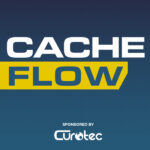Marin Smiljanic is the Co-Founder and CEO of Omnisearch, leading a dynamic career in technology and entrepreneurship. With experiences ranging from being a Software Development Engineer at Amazon, where he contributed to projects like Alexa’s email feature, to founding QuickNews and QN Technologies, Marin’s journey reflects his commitment to innovation and software engineering expertise. Here are a few of the topics we’ll discuss on this episode of Cache Flow:
- Unlike other search vendors, Omnisearch aims to provide a holistic solution, allowing customers to handle all their search needs in one place.
- S3’s underlying architecture from 2006 is still largely in place today.
- Move fast and break things was retired at Facebook, and replaced with move fast and ship working software.
- B2B vs B2C: B2B products can have bigger success if tailored to customer needs.
- WeChat’s success in China might be due to centralized data tracking instead of separate companies.
- The concept of consciousness in technology is complex and debatable.
- The robots turn to harvesting humans for energy, setting the stage for the Matrix movie.
Resources:
Connect with Marin Smiljanic:
Connect with our host, Brian Dainis:
Quotables:
-
- 14:05 – “I would say that what is good there, and that’s kind of an extreme case of what you’ll sometimes see in big tech, is you really get to witness a masterclass of distributed systems, scalability, all these, important concepts that back when we were taking distributed systems in college, the examples there would’ve been like, simple client-server architectures or something that at most had a couple of machines, then you go to S3 and that’s like hundreds of thousands of machines. So definitely your intuitions about this, your ways of reasoning about systems. They change very fundamentally, in ways that you couldn’t do in smaller companies.”
- 15:18 – “The downside of S3, you alluded to this, it’s a very mature product, which means there’s no cowboy-ish approach. There’s no major incentive, I would even say to ship it super fast. Rather, it’s like, don’t break first order of business, don’t break things. So that can be a little bit frustrating when you’re a young eager beaver and want to ship things, get things into production as soon as you can. And then it’s like, ah, but did you think of this angle? And then you have got to think about that angle. So it, it helps with discipline, but maybe it’s not the most exciting part.”
- 57:27 – “So getting the lead to the CEO and then the CEO getting that customer to sign up and the CEO’s onboarding that customer. That’s like, I think in early days, like when the CEO, the Founder, when it’s like a five-person team or a two-person team or whatever. That’s, I think, the way that it needs to be done. So that you can actually get that real-time feedback from customers like, oh, this feature doesn’t work, or I hate this or I need this. And that’s like, if you start to see a theme emerge from first customer, second customer, third customer saying the same things and it’s obvious that you need to fix that because you’re talking to them and they’re giving you that info, but the feedback cycle might be like so much longer or not even there if you’re trying to do PLG too early.”
- 26:38 – “I’m involved in another company that did that just like did an acquisition and they acquired asset was monetized on ads. But the way that the company’s going to monetize that asset is through like a B2B sales channel, not ads, but selling… Basically like a data product and the monetization is 100x or it’s more than 10x. The traffic is monetized. It might not be 100x, but it’s like more than 10x for sure.”
- 56:05 – I’ve actually subscribed to the opposite school of thought, that the PLG is “Product-Led Growth” for the listeners. So we’ve talked about Product Led Growth on other episodes, but essentially Product-Led Growth is like building in features to your product that are like an onboard to your product. So the user doesn’t have to talk to a sales team to use your product. They can just like go click a button, sign up, put a credit card in, and then there’s like an onboarding ramp right into the product that helps them, like a wizard or something or like a step one, step two, step three onboarding that helps them get set up in your product ecosystem. But doing Product-Led Growth or PLG too early in the lifecycle of a company, I think is a disservice. That’s at least the school of thought I subscribed to. Because if you’re not fully validated yet and you start to try to do PLG, like if it’s not working, what do you start to troubleshoot first? Is it like your ads aren’t the right copy, is your landing page not right? Is your PLG not right? Or is your product and your product thesis as a whole not right? Like where do you start to troubleshoot?”





